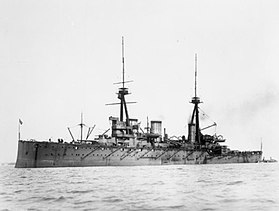HMS Inflexible (1907)
|
|
|
|---|---|
 HMS Inflexible |
|
| Overview | |
| Type | Battle cruiser |
| Shipyard |
John Brown & Company , Clydebank |
| Keel laying | February 5, 1906 |
| Launch | June 26, 1907 |
| delivery | . October 1908 |
| period of service |
1908-1920 |
| Decommissioning | March 31, 1920 |
| Whereabouts | Sold for demolition in 1922 |
| Technical specifications | |
| displacement |
17,526 ts , max. 20,135 ts |
| length |
171 m |
| width |
23.9 m |
| Draft |
8.2 m |
| crew |
784-1,000 men |
| drive |
31 Yarrow boilers |
| speed |
28 kn , |
| Range |
6,330 nm at 10 kn, |
| Armament |
|
| Bunker possibility |
3,170 ts of coal |
| Armor | |
| Belt armor |
51–152 mm (2–6 in) |
| Towers |
102–178 mm (4–7 in) |
| Armored deck |
25–64 mm (1–2.5 in) |
| Command tower |
254 mm (10 in) |
| Sister ships | |
The HMS Inflexible (English: for rigid, relentless) was one of three battlecruisers of the Invincible class . It was built at John Brown & Company in Clydebank .
When the First World War broke out , the Inflexible was the flagship of the British Mediterranean fleet . Between 4th and 10th August 1914 she was involved in the hunt for the SMS Goeben before she was ordered back to Great Britain . Between October 1 and October 10, 1914, she was on patrol in the Shetland Islands, where she was supposed to protect a troop transport, before she was transferred to the South Atlantic on November 4, 1914 after the British defeat at Coronel . She arrived at Port Stanley in the Falkland Islands on December 7, 1914 , one day before the battle of the same name . Here, the ship took part in the destruction of the German East Asia Squadron without being damaged itself.
On December 19, 1914, she was ordered to go to the Mediterranean. On the way to Gibraltar the ammunition and coal stocks were replenished. Shortly thereafter, on January 24, 1915, she became the flagship of the fleet used by the Dardanelles . On March 18, 1915, she was hit twice by cannon fire from Turkish forts in the Dardanelles Strait, killing nine men. On the same day she ran into a mine and was forced to retreat by 2,000 tons of falling water. After the repair in Gibraltar, the Inflexible was withdrawn from the Dardanelles because the tasks there were then taken over by older liners . She returned to Great Britain and strengthened the Grand Fleet from June 19, 1915 .
On May 31, 1916, she took part in the Battle of the Skagerrak , where she was not damaged - in contrast to her sister ship Invincible , which exploded after being hit. The rest of the war went on for the inflexible , apart from a serious collision accident in January 1918 , without special events. She was transferred to the reserve fleet in 1919 before being decommissioned on March 31 and sold for cannibalization in December 1922.